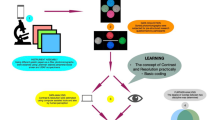Abstract
A new teaching method, using multimedia software, is in progress at our university. Running on a PC computer, it allows self-formation in molecular spectroscopy. A new software package devoted to photoluminescence (ISPL) is currently in progress. The concepts are introduced by using numerous graphs, animations, and simulations. The software allows electronic book facilities (search function, glossary, and bookmarks, for instance) and self-assessment. Tedious and time-consuming training is always necessary to acquire experimental skill. This is particularly true in the case of luminescence because numerous artifacts are possible and the number of parameters to be optimized is very large. In this view, a spectrofluorometer simulator appears to be a valuable tool that makes this training easy and fast: after choosing a set of experimental parameters, the computer displays immediately the corresponding spectrum. The influence of every experimental parameter is simulated: monochromator slit width, excitation or emission wavelengths, xenon source type, photomultiplier tube high-voltage, etc. The nature of solvents, with first- and second-order Rayleigh and Raman scattering, is managed. Sample geometry and concentration, with a corresponding inner filter, are also simulated. Obviously, there is no risk of damaging the virtual photomultiplier tube.
Similar content being viewed by others
REFERENCES
W. Karcher, J. Devillers, Ph. Garrigues, and J. Jacob (1991) in Spectral Atlas of polycyclic aromatic compounds Vol. 3, Kluwer Academic Publishers, Dordrecht, pp. 10-11; R. M.Williams (1993) EPA Newsletter, 49, 3-8.
National Bureau of Standards (1979) Certificate Standard Reference Material No. 936.
J. M. Lerner and A. Thevenon (1988) in The Optics of Spectroscopy, Instruments SA, Inc., pp. 21, 25.
T. Owen (1996) in Fundamentals of Modern UV-Visible Spectroscopy: A Primer, Hewlett-Packard Company, pp. 52-55.
F. C. Strong (1976) Anal. Chem. 48, 2155-2161.
A. G. Marshall and F. R Verdun (1990) in Fourier Transforms in NMR, Optical, and Mass Spectroscopy:A User's Handbook, Elsevier, Amsterdam,pp.38-56.
H-H. Perkanpus (1992) in UV-VIS Spectroscopy and Its Applications, Springer-Verlag, Berlin, pp. 220-223.
C. A. Parker (1968) in Photoluminescence of Solutions, Elsevier, Amsterdam,pp.15-22.
D. Rendell (1987) in Fluorescence and Phosphorescence Spectroscopy, ACOL, John Wiley, London, pp. 88-99.
Ref. 8, p. 26. 500
Ref. 8, pp. 13, 14.
Ref. 3, pp. 34, 36.
Ref. 8, pp. 220-234.
Ref. 8, pp. 246-261.
Author information
Authors and Affiliations
Rights and permissions
About this article
Cite this article
Dalibart, M., Belin, C. Multimedia Tools for Learning Fluorescence: A Spectrofluorometer Simulator. Journal of Fluorescence 10, 217 (2000). https://doi.org/10.1023/A:1009411619924
Issue Date:
DOI: https://doi.org/10.1023/A:1009411619924




